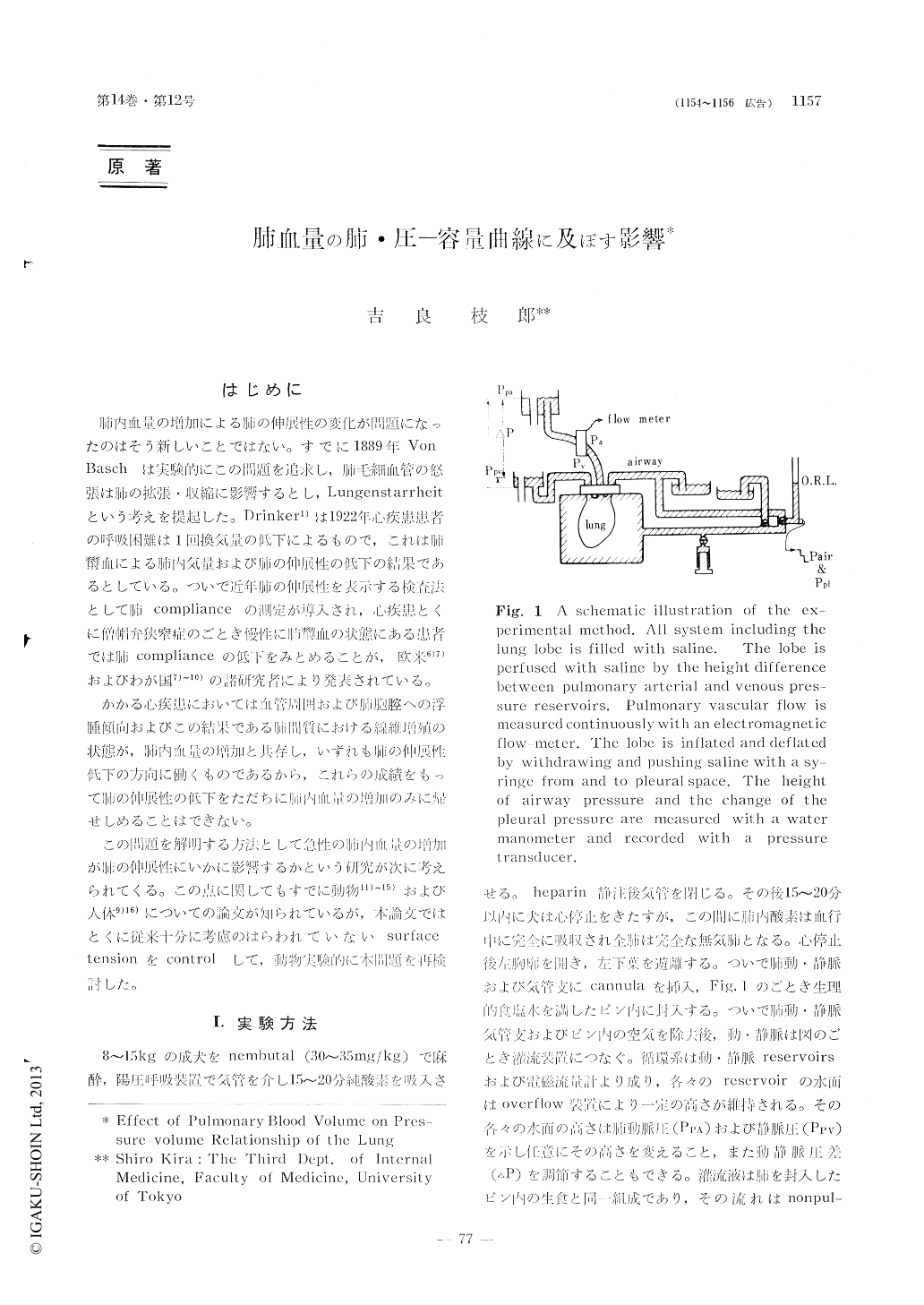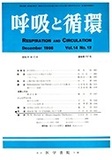Japanese
English
- 有料閲覧
- Abstract 文献概要
- 1ページ目 Look Inside
はじめに
肺内血量の増加による肺の伸展性の変化が問題になったのはそう新しいことではない。すでに1889年Von Baschは実験的にこの問題を追求し,肺毛細血管の怒張は肺の拡張・収縮に影響するとし,Lungenstarrheitという考えを提起した。Drinker1)は1922年心疾患患者の呼吸困難は1回換気量の低下によるもので,これは肺欝血による肺内気量および肺の伸展性の低下の結果であるとしている。ついで近年肺の伸展性を表示する検査法として肺complianceの測定が導入され,心疾患とくに僧帽弁狭窄症のごとき慢性に肺欝血の状態にある患者では肺complianceの低下をみとめることが,欧米6)7)およびわが国7)〜10)の諸研究者により発表されている。
かかる心疾患においては血管周囲および肺胞腔への浮腫傾向およびこの結果である肺間質における線維増殖の状態が,肺内血量の増加と共存し,いずれも肺の伸展性低下の方向に働くものであるから,これらの成績をもって肺の伸展性の低下をただちに肺内血量の増加のみに帰せしめることはできない。
The effect of acute increase of pulmonary blood volume on the pressure-volume rela-tionship of the lung was studied in the saline-filled lung lobe. Because the inside as well as the outside of the lobe was filled with saline the hydrostatic pressure differ-ence inside the pulmonary vessels was eli-minated and the intravascular pressure dis-tribution was uniform throughout the lobe. Furthermore, surface tension on the air liquid surface within alveoli was also eliminated by this method.
Acute increase of pulmonary blood volume was induced by elevation of pulmonary arte-rial pressure. At the same time, pulmonary vascular flow was also increased because of increase of the pressure gradient between pulmonary arterial and venous pressures. The lobe was inflated with the negative pressure inflation method in low (Ppa at 4.0±0.5 and Ppv, 0.5±0.5cm water) and high (Ppa at 12.0±0.5 and Ppv, 0.5±0.5cm water)pulmonary vascular pressure conditions and resulting pressure-volume curves of the lobes were compared in both conditions.
There were no hysteresis loop in pressure-volume curves because surface tension was eliminated. The correlation between trans-pulmonary pressure and volume of the lobe was quite linear. From the results in 17 exps. with 6 dogs in the low vascular pres-sure condition and in 14 exps. with 5 dogs in the high vascular pressure condition, following experimental formulae concerned with the transpulmonary pressure and lobe volume were obtained:in the low pressure condition, Yc=1.26X-0.93 and in the high pressure condition, Yc=1.25X-0.92 in which Yc and X mean lobe volume in ml/gr of wet weight of the lobe and transpulmonary pres-sure in cm water respectively. The gradient of this equation means the ratio of increment of the lobe volume and increment of trans-pulmonary pressure,Δv/Δp, which corres-ponds to pulmonary compliance. From these results no definite change of lung compliance was observed in both conditions.
Previous studies by several workers did not sufficiently control surface tension which is an important factor to decide the history of pressure volume diagram. Also they used a positive pressure inflation method in their studies. Their method is not appropriate to study this subject because it is clearly known that increase of airway pressure does comp ress the vessels especially around alveolar space and decreases blood volume in these vessels through vascular compression. From these reasons, surface tension arc elimi-nated and the negative pressure method areused in the present study.
It is suggested from present experiments that blood volume does not affect lung com-pliance and the mechanism for decreased lung compliance in chronic heart failures, especially in mitral stenosis, is not clue to the grade of congestion in the pulmonary circulation, but to edematous tendency and histological changes, for example fibrotic change, in the lung.

Copyright © 1966, Igaku-Shoin Ltd. All rights reserved.


